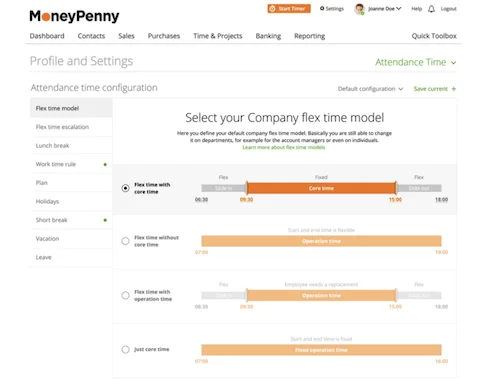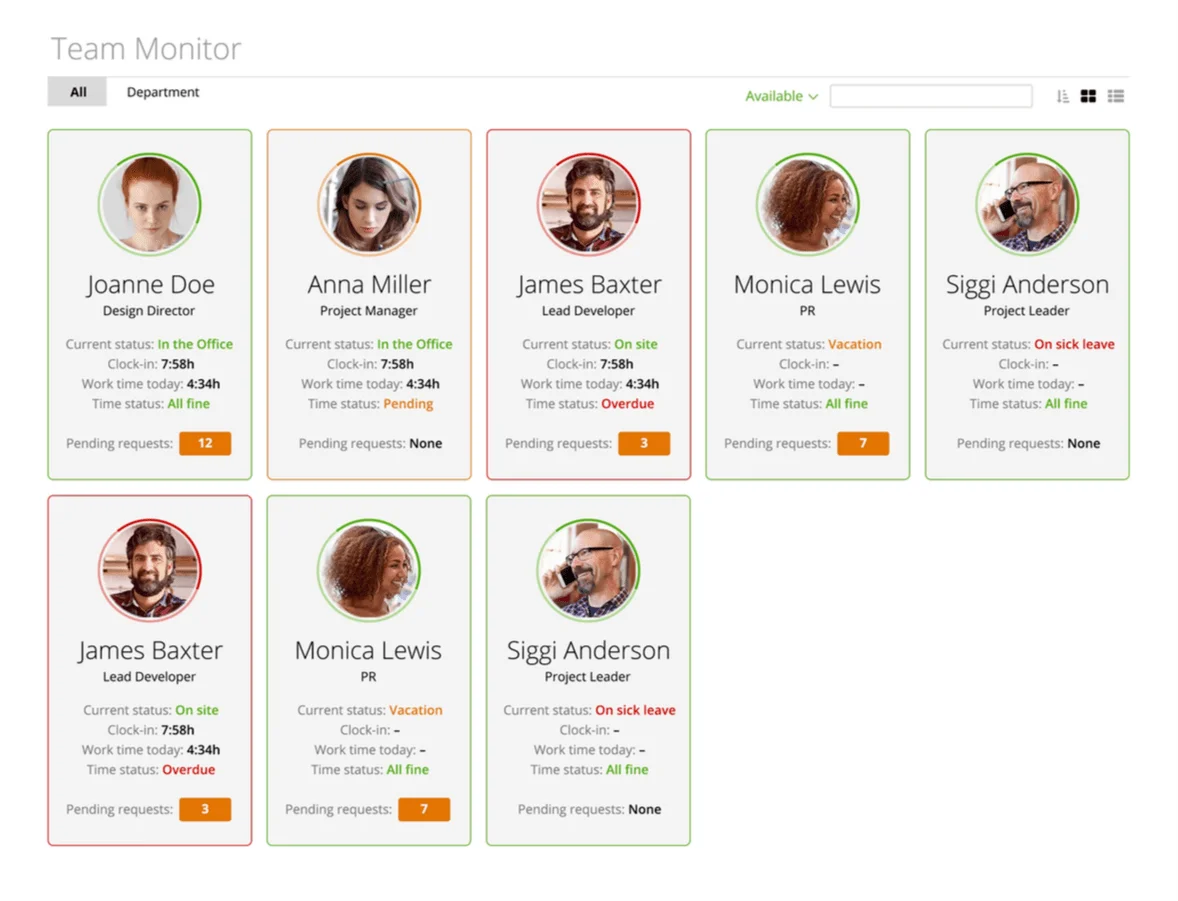Is your business up for the ultimate Time and attendance challenge? Make Flex Time work!
What is Flex Time?
A flex time policy is a flexible time scheme used by companies to organize working hours. It is a type of flexible work arrangement that allows different starting and departure times, giving employees schedule flexibility to customize their work schedules to fit personal and business needs. It usually includes a fixed “core time” interval – for instance from 11 am to 2 pm - when all employees must be in the office. Employees work the same number of hours as in traditional schedules, but with flexibility in when those hours are worked, thanks to flexible working hours and flexible work policies.
70% of employees felt that positions were more attractive if Flex Time was available
There’s no reason why in our modern world of digital technology and secure cloud computing that employees have to be at their desks from nine to five. When companies implement flextime or other flexible work arrangements, they allow employees to work at home for part of the time or choose their office hours. This flexibility allows employees to start early or adjust their schedules as needed, supporting both workplace flexibility and business needs. Distractions like workplace politics and water-cooler chats disappear while staff morale is boosted. And, as an added bonus, take out the hour or more that many employees spend commuting to work during rush hours and a longer time can be devoted to productive employment. For example, a flexible schedule may allow an employee to attend a yoga class during the day and make up the hours worked later.
Flex time policies allow employees to create personalized work schedules, but clear communication and coordination among team members are essential to maintain productivity and positive team dynamics in flexible work arrangements. When implementing flex time, companies should consider different types such as compressed work schedule, split shift, variable day schedule, and flexible time arrangement to best fit their operational requirements. Job sharing is another flexible work arrangement, ideal for those seeking part time jobs. Implementing flex time and implementing flextime requires careful planning to align with business needs and ensure workplace flexibility. Flexible work not only improves employee experience but also supports well-being and job satisfaction.
Flex Time can work in different ways:
There are different ways in which Flex Time can work:
- setting up a core time when all employees must be in the office, and let them adjust the start and end work time due to personal needs
- employees can choose to work longer hours on some days to give them a three-day weekend or a mid-week day off
- they can split their time between working at home and their place of employment
‘Work’ becomes an activity rather than a ‘place’.
Setting Up Flex Time Rules in zistemo Time and Attendance Software
67% of employees wished that they were able to work flexible hours
Types of Flextime Schedules: Job Sharing and Other Arrangements
Flextime schedules come in many shapes and sizes, allowing businesses to tailor flexible working arrangements to fit both operational needs and employee preferences. One popular option is job sharing, where two or more employees split the duties of a single full-time role. This arrangement is ideal for those seeking part-time work or a better work life balance, as it allows employees to manage their personal commitments while still contributing to the team.
Other flextime schedules include compressed workweeks, where employees work longer hours over fewer days—such as four 10-hour days instead of five 8-hour days—giving them extra time off to recharge. Staggered hours are another flexible working solution, letting employees start and finish their workdays at different times to avoid peak hours or accommodate personal needs. These flexible working arrangements not only help employees work longer hours when needed but also support a personalized work schedule that can enhance employee satisfaction, increase productivity, and improve overall work life. By offering a variety of flextime schedules, businesses can create a more adaptable and supportive work environment for all employees.
Does Flex time work for all businesses?
In theory, any employee could work flexible hours. In practice, however, flexible work arrangements and schedule flexibility must be tailored to the specific business needs and work arrangement of each organization. There are situations where it’s harder to manage, such as when face-to-face customer interaction is required during specific hours.
Implementing flextime and implementing flex time in customer-facing roles requires careful consideration of work schedules and hours worked to ensure business operations are not disrupted. Team dynamics and coordination among team members are also crucial when adopting flexible working conditions, as effective collaboration and communication are essential for maintaining productivity.
Flex Time is easier to manage in employment situations that are less customer-focused such as distribution centers, production lines or the world of IT, many of which run 24-hours a day. In these situations, Flex Time can benefit both employers and employees. So, what are the pros and cons of Flex Time?
Creating a Flextime Policy
Implementing a successful flextime policy starts with understanding your business’s unique needs and the types of flexible schedules that will work best for your team. Begin by gathering input from employees, analyzing work hours and workload patterns, and consulting with your HR team to identify the most effective flexible hours and core hours for your organization. Once you’ve established the framework, it’s essential to communicate the policy clearly—outlining when employees are expected to be available during core hours, how flexible schedules can be arranged, and any limitations or guidelines that apply.
A well-crafted flextime policy should also include a reliable system for tracking work hours and monitoring productivity, ensuring that both business goals and employee needs are met. By setting clear expectations and providing the right tools, you can help employees make the most of flexible hours while maintaining smooth business operations.
Benefits of Flex Time Model
Flex time model is beneficial for both employees and business owners.
Flexible work and flexible working hours contribute to increased job satisfaction, employee morale, and overall well being. By allowing employees to customize their schedules, flexible work arrangements support mental health and well being, as flexible schedules can reduce stress and improve overall quality of life. For example, employees can use their flexible schedule to attend a yoga class during the day, supporting their mental health and overall well-being.
Schedule flexibility and workplace flexibility can lead to greater productivity and increased productivity, as employees are able to work during their most productive hours and maintain a better work-life balance. Flexible working conditions and clear communication are essential for maximizing the benefits of flexible work, ensuring that everyone remains aligned and productive.
Flexible work arrangements can also allow for comp time, where employees work extra hours during busy periods and take fewer hours or time off during slower times. This approach not only supports employee experience but also helps businesses adapt to changing workloads.
When it comes to cost savings, flexible work arrangements can reduce the need for physical office space, leading to lower expenses and more efficient use of resources.
58% of those surveyed believed that working away from the office would help their motivation
Good news for employees: Improved Work Life Balance
An improvement in work-life balance. Without a rigid 9-to-5 working day, there is a positive gain for employees juggling the care of children or elderly relatives. With flexible working hours and schedule flexibility, couples can often take on more of these roles themselves rather than paying for expensive childcare or care packages, supporting their well being, overall well being, and mental health.
Employees with ongoing health problems or treatment schedules can fit these into their lives without missing out on productive time, while others who want to take professional courses or attend a yoga class or other wellness activities can do so around their flexible schedule. Flexible working conditions and flexible work arrangements contribute to increased job satisfaction, employee morale, and a positive employee experience.
Employees on Flex Time can arrange their day to avoid peak rush-hour traffic or overcrowded trains. A valuable benefit that is much appreciated and may mean the difference between a highly qualified and experienced member of the team leaving and staying.
Flexible work arrangements can also allow employees to work extra hours during busy periods and then take time off or work fewer hours during slower times, further enhancing schedule flexibility and work-life balance.
When employees aren’t worried about fitting in outside obligations, feeling guilty because they need time off for yet another appointment, or arriving hot and bothered after a nightmare commute, they’re freed up to focus on their job rather than personal issues. A win-win situation for them and their employers.
In-real Time Preview of Team Perfomrance with zistemo
Good news for business owners and managers
53% felt their productivity would increase if they could work outside the office
Having the ability to offer Flex Time and other flexible work arrangements means critical vacancies are more likely to attract the right staff to fill them. In fact, more and more qualified and experienced applicants expect workplace flexibility and flexible working conditions as a benefit of employment, which helps attract and retain talent and improves the overall employee experience.
Flex Time allows businesses to make the most of their employees’ circadian rhythms by enabling flexible working hours and schedule flexibility. Night owls can work into the evening while those that rise with the lark can beat the traffic to make an early start on their daily tasks. Matching work schedules and work arrangements to business needs can lead to greater productivity and increased productivity, as employees are able to work during their most effective hours.
With flexible hours, employers can match staff presence to the times when demand for their service or business is at a peak. If the phone starts ringing at 6:00 am or techie support is needed late at night, then Flex Time means a ‘human’ voice is always available. Implementing flex time requires clear communication and coordination among team members, and attention to team dynamics, to ensure everyone is aligned and collaboration remains strong.
Flex Time can lead to lower overhead costs. When employees are working different hours, office equipment and office space can be shared or reduced, having an impact on heavy overheads that might make all the difference when a small business is balancing its books. Implementing flex time and flexible work arrangements can also improve the employee experience by supporting work-life balance and operational efficiency.
Supporting Working Parents
For working parents, balancing professional commitments with family responsibilities can be a daily challenge. Flexible working arrangements, such as flexible schedules, telecommuting, and compressed workweeks, offer valuable support by allowing parents to better manage their work life and personal life. These options can help reduce stress, improve work life balance, and ultimately lead to greater job satisfaction.
Employers can further support working parents by providing resources like parental leave policies, childcare assistance, and employee assistance programs. By embracing flexible working and offering tailored support, businesses not only help working parents thrive but also foster a more inclusive and satisfied workforce.
Is it all good news?
How to overcome the cons of Flex Time?
Many businesses have been using flexible scheduling for some years now, meaning the downside of Flex Time has become more apparent. What works beautifully in one situation, can be a massive headache in another.
If your business employs just a handful of people, scheduling in those flexible hours is straightforward. When a company has hundreds, if not thousands, of employees, trying to meet their needs and keep daily operations running smoothly can become a Human Resources nightmare. To keep daily operations running smoothly and bring teams together, some employees may have to come into work during their own hours – not good for either employee morale or motivation.
When people are sharing roles and responsibilities, their working methods and styles need to gel and clear communication between team members needs to be ultra-effective. If not, projects will suffer from delays and inconsistencies. Implementing flex time and scheduling meetings across diverse time zones require careful planning to support positive team dynamics and ensure coordinated availability. When you implement flextime, addressing potential issues like proximity bias is essential to protect both employee morale and the overall employee experience.
Businesses often run on teamwork and for employees working in a team and building a relationship with co-workers is an enjoyable and motivating part of their work life. Friendships and even romantic relationships are made at work but when everyone is starting and finishing at different times or spending hours working at home, the chance to come together over a morning cup of coffee or an after-work drink can be lost.
Role of Human Resources in Managing Flextime
Human Resources plays a pivotal role in the successful implementation and management of flextime within any organization. The HR team is responsible for developing clear flextime policies, ensuring that guidelines are communicated effectively to all employees, and maintaining fairness and consistency across the board. HR professionals also monitor the impact of flextime on work hours and business operations, using tools like time tracking software to keep an eye on productivity and attendance.
When issues or concerns arise, HR is there to address them promptly and make necessary adjustments to the policy. By actively managing and supporting flextime, human resources help create a flexible working environment that benefits both employees and the business as a whole.
3 Tips to Make Flex Time work for your business!
There is no legal requirement to offer Flex Time to employees. Although business owners can limit Flex Time to specific situations, if it is offered it cannot be discriminatory and should be available to all workers. To ensure it works for your business:
- Write clear policies for staff and managers to follow, then embed these in your employee handbook and make them part of your initial staff training procedures. When you implement flextime or are implementing flex time policies, clear communication is essential to prevent misunderstandings and ensure everyone understands expectations.
- Simplify personnel scheduling by making use of our Automated Time Attendance Software. Employers and employees can easily keep track of working hours with this cloud-based software package. When data is collated and clearly displayed on time sheets, managing Flex Time immediately becomes quicker and easier. Focusing on employee experience and schedule flexibility can help ensure the success of flex time arrangements.
- Use live time tracker and know in real time who is working on which project, who is on holiday or even who is taking a lunch break. It shows which employee is in the office and who is working from home or elsewhere, allowing for close monitoring of both teamwork and productivity.
30% if given the choice, would prefer the opportunity to work flexible hours rather than have a pay rise
Monitoring and Evaluating Flextime
To get the most out of flexible working arrangements, it’s important for businesses to regularly monitor and evaluate their flextime policies. This means tracking key indicators such as employee satisfaction, productivity, and work life balance. Gathering feedback through surveys, focus groups, or one-on-one conversations can provide valuable insights into what’s working and where improvements are needed.
By continuously assessing the effectiveness of flexible working, employers can make informed decisions, refine their policies, and ensure that flexible arrangements continue to enhance employee satisfaction and support a healthy work life.
Set up and manage Working Hours with zistemo
Managing flexible working arrangements and tracking working hours can be a challenge, but zistemo’s time tracking software makes it simple. With zistemo, employees can easily log their work hours, track their productivity, and receive helpful reminders to stay on schedule. Employers benefit from real-time insights into attendance and work hours, making it easier to evaluate the effectiveness of flexible working arrangements and ensure compliance with company policies.
Zistemo allows employees to enjoy the benefits of flexible working while giving businesses the tools they need to optimize their work environment and enhance employee satisfaction. By streamlining time tracking and reducing administrative tasks, zistemo helps create a more efficient, supportive, and productive workplace for everyone.
Set up and mange Working Hours with zistemo
Our Automated Time Attendance software also feeds data seamlessly into payroll preparation while keeping a track of tax, social security, pension and holiday pay obligations.
A reliable automated tracking system that employees trust does away with workplace resentment. When everyone’s hours are monitored, workers that used to add a few minutes to their lunch breaks or habitually arrived late and left early can no longer do so without being caught out.
With the right policies in place and the right software, your business is ready for the ultimate time and attendance challenge - Flex Time.
Find out some more interesting stats about flex time from a 2017 survey by powwownow.co.uk





